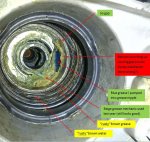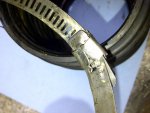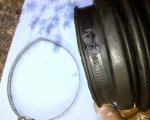skydiveD30571
Lieutenant Junior Grade
- Joined
- Feb 13, 2012
- Messages
- 1,042
2007 VP SX-A drive
Removed the drive yesterday to check alignment, grease the splines, and make sure the u-joint bellows were dry. Well, they weren't. In fact they had a very large puddle of greasy cloudy standing water. :facepalm:
I pulled the drive earlier this year (end of June) to chase down a ticking noise. I learned that it was the metal coil wire inside the originally-installed u-joint bellows so I replaced it with new OEM parts. Being basically the same as an SX drive I followed Don's advice and did it without pulling the pivot housing (Removed drive, water tube, and exhaust bellows to make room). I would have put money on the fact that I did it right, it was straightforward and seemed easy. I made sure the clamp was nice and tight and at the 2 oclock position to not limit drive movement or puncture anything. I made sure the lip was secure around the whole diameter of the bellows on the pivot housing. Well, all that water had to come in from somewhere. (water was removed before pictures were taken)
First question: Does water get into the blue outlined area here? It seems like the drive would have to be seamlessly flat with the pivot housing or water would get in there. If thats normal, is it the tapered edge of the pinion bearing housing that keeps water out of the u-joint bellows? I also noticed that the bellows lip has 4 indents in it now, that weren't in the original bellows (red arrow). It seems like these were caused from the corners of the bearing housing in the second picture (also red arrow). If water can get around the bearing housing, could it have made it thru those indentions? Why are they there now and never have been before?
![20121017_123736[1].jpg 20121017_123736[1].jpg](https://forums.iboats.com/data/attachments/145/145276-743106d3eee2e454bbfd02a485493f1e.jpg)
I also took this picture to show the u-joints. With the amount of water in the bellows I'm not surprised to see some rust, but there's not much and I spent a long time playing with the u-joints and they move as perfectly as they ever have in every axis with no grinding or play whatsoever. They are the sealed non-serviceable type, so I'm wondering if it's just a little surface rust. Being that I never heard or noticed a problem on the water (and still don't) and that replacing them means replacing the whole driveshaft, I think I may keep them if/until a problem arises. Unless it's just a horrible idea. The gimbal bearing, although still smooth with no grinding, takes more force to turn than it did earlier this summer so I imagine it will need replaced. I don't believe it can be greased either.
![20121017_123402[1].jpg 20121017_123402[1].jpg](https://forums.iboats.com/data/attachments/145/145277-860b5708a66c8f6a29af4246800e499e.jpg)
As for the other side of where the bellows attaches, it is perfectly flush all the way around (blue arrows) except for the little bump at the top (red arrow). Examining with a light and fingers I couldn't feel or see any way water could intrude there. Anybody have comments on that? I'm guessing I need to take the bellows off and examine it anyways but I would be surprised if it had a hole already. But you never know.
![20121017_123912[1].jpg 20121017_123912[1].jpg](https://forums.iboats.com/data/attachments/145/145278-3e10ab178dd13c0b30968be9666ed190.jpg)
So, anyone have any guesses where a good liter or so of water could intrude? Also, I see no signs of water intrusion inboard of the gimbal. Drive shaft splines and coupler splines all have clean water-free grease. Any help would be great. Thanks as always!
Removed the drive yesterday to check alignment, grease the splines, and make sure the u-joint bellows were dry. Well, they weren't. In fact they had a very large puddle of greasy cloudy standing water. :facepalm:
I pulled the drive earlier this year (end of June) to chase down a ticking noise. I learned that it was the metal coil wire inside the originally-installed u-joint bellows so I replaced it with new OEM parts. Being basically the same as an SX drive I followed Don's advice and did it without pulling the pivot housing (Removed drive, water tube, and exhaust bellows to make room). I would have put money on the fact that I did it right, it was straightforward and seemed easy. I made sure the clamp was nice and tight and at the 2 oclock position to not limit drive movement or puncture anything. I made sure the lip was secure around the whole diameter of the bellows on the pivot housing. Well, all that water had to come in from somewhere. (water was removed before pictures were taken)
First question: Does water get into the blue outlined area here? It seems like the drive would have to be seamlessly flat with the pivot housing or water would get in there. If thats normal, is it the tapered edge of the pinion bearing housing that keeps water out of the u-joint bellows? I also noticed that the bellows lip has 4 indents in it now, that weren't in the original bellows (red arrow). It seems like these were caused from the corners of the bearing housing in the second picture (also red arrow). If water can get around the bearing housing, could it have made it thru those indentions? Why are they there now and never have been before?
![20121017_123736[1].jpg 20121017_123736[1].jpg](https://forums.iboats.com/data/attachments/145/145276-743106d3eee2e454bbfd02a485493f1e.jpg)
I also took this picture to show the u-joints. With the amount of water in the bellows I'm not surprised to see some rust, but there's not much and I spent a long time playing with the u-joints and they move as perfectly as they ever have in every axis with no grinding or play whatsoever. They are the sealed non-serviceable type, so I'm wondering if it's just a little surface rust. Being that I never heard or noticed a problem on the water (and still don't) and that replacing them means replacing the whole driveshaft, I think I may keep them if/until a problem arises. Unless it's just a horrible idea. The gimbal bearing, although still smooth with no grinding, takes more force to turn than it did earlier this summer so I imagine it will need replaced. I don't believe it can be greased either.
![20121017_123402[1].jpg 20121017_123402[1].jpg](https://forums.iboats.com/data/attachments/145/145277-860b5708a66c8f6a29af4246800e499e.jpg)
As for the other side of where the bellows attaches, it is perfectly flush all the way around (blue arrows) except for the little bump at the top (red arrow). Examining with a light and fingers I couldn't feel or see any way water could intrude there. Anybody have comments on that? I'm guessing I need to take the bellows off and examine it anyways but I would be surprised if it had a hole already. But you never know.
![20121017_123912[1].jpg 20121017_123912[1].jpg](https://forums.iboats.com/data/attachments/145/145278-3e10ab178dd13c0b30968be9666ed190.jpg)
So, anyone have any guesses where a good liter or so of water could intrude? Also, I see no signs of water intrusion inboard of the gimbal. Drive shaft splines and coupler splines all have clean water-free grease. Any help would be great. Thanks as always!




















![20121017_123912[1].jpg 20121017_123912[1].jpg](https://forums.iboats.com/data/attachments/146/146467-8ceda59f97bfeb6b31c1c0752abd5179.jpg)



